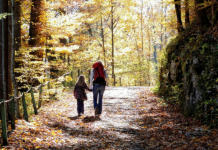 I am sharing my family’s first experience with lice as we remember it in the hopes that it finds someone who needs comfort.
I am sharing my family’s first experience with lice as we remember it in the hopes that it finds someone who needs comfort.
It began as a sneak attack…
About a month ago my daughter had trouble sleeping. Assuming it was a nightmare, my husband reluctantly crawled into her bed to settle her back down, as I was already dealing with our teething baby. The next morning I took both kids strawberry picking as our springtime ritual. My daughter seemed distracted. That’s when I noticed (dun, dun, dun) the itch.
Having been taken completely by surprise, I then met my enemy through the lush forest.
Seeing a small, nearly translucent-gray bug trying to live on my children made me both disgusted and furious. My husband and I had been lucky to survive our own childhood without facing lice, but that streak had ended.
I rushed us all home, while my husband went to buy an over the counter lice treatment kit. I refused to let the kids back in the house until the shampoo was in place. So they played with chalk on the driveway while I proceeded to go mad wondering how this happened in the first place.
The deception…how could they get lice during self-isolation?
We had been in self-isolation for four weeks due to the pandemic. They had not seen any kids or adults outside of our home for any reason. We had been careful not to even take them to the grocery store or gas station. Strawberry picking, with many extreme social distancing measures in place, was to be our first and only reprieve into the world. Moreover, my husband and I still miraculously did not have any signs of lice, even after we both slept in their beds the night before. So I asked again, how?
Everything I read said lice comes as a transfer from human to human. They can NOT fly or jump from head to head. A “louse” cannot survive without human blood for more than 24 hours. My kids, and a few more throughout South Carolina I later found out, were to be the exception.
We still don’t know for sure how they could have contracted it – albeit an extremely rare scenario. So while there were no embarrassing phone calls to other parents, there was a deeper feeling of isolation and initial defeat that set in for my family.
I spent hours in reconnaissance studying my enemy.
Other than a particularly cringe-worthy episode of The Office, I had no understanding of lice. So, I set to doing some research.
Here are some of my biggest take-aways:
- Lice actually prefer clean heads to dirty ones because their nits (or eggs) can attach to the hair better. The tiny white ovals use a sticky substance to attach to the hair shaft. The difference between this and dandruff flakes is that the dandruff flakes will move when shaken.
- Lice are not attracted to pets. The blood they need to thrive must be human blood.
- Lice can be found on other surfaces in the house, such as pillow case or car seat, but it is very unlikely. Sanitizing all those items is important, but if you experience a re-infestation it is more likely the cause of missing even one egg in the hair.
- There is a real thing called “Super Lice.” It is a type of lice that has grown resistant to many chemical treatments meant to kill lice – usually by suffocation. That is why the suggested best practice by NPA (National Pediculosis Association) is to comb hair thoroughly with a specialized lice comb to remove nits, rather then using chemicals.
- Even if you do not see or feel lice, treat yourself and any other person in the house hold to lessen the chance of infestation.
- Continue to treat again within seven to ten days, as that is how long it takes for eggs to hatch. The larger the infestation, the more times you may need treatment. This is not a one-and-done experience. Prepare yourself to deal with this for weeks.
- Do NOT wait to treat. While lice do not carry disease, the excessive itching can likely cause a skin rash or infection. This can even eventually lead to some hair loss with the irritation with the scalp continues. Lice will not go away on their own.
- Kids are generally less freaked out if you explain the scientific truth to them. As an adult obsessed with cleanliness, I often underestimate a child’s fascination with bugs.

Human head lice being studied over the last two centuries. Photo credit: headlice.org
Planning a strategic offense
There are several options for treatment. The first is home treatment. Obtain a nit comb meant for removal of both the adult louse and the nits before hatching. If you do use a shampoo treatment, remember it will not kill the nits (a.k.a the eggs) so you will need to comb as a vital part of treatment.
There are also professionals who can do a home treatment, which often includes help with de-lousing items around the home as well.
Lastly, there are lice treatment salons or clinics that will handle the treatment for you entirely. These may be expensive options, but they do often offer guarantees that if re-infestation occurs, they will treat again at no cost. You can search for one, but please note there is not a location in Columbia and you may need to drive up to 50 miles.
Lice does not need to be a shameful experience. The louse is just struggling to survive and raise its own kids. It happens. When it does, know there are tools to fight back. You are not a lesser mother. You are a warrior. You can claim victory!














